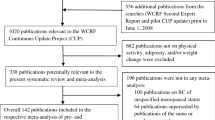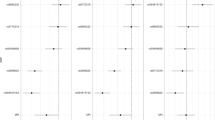Abstract
Purpose
With only 5–10% of breast cancer cases attributed to genetic inheritance, prevention efforts have focused on modifiable risk factors. Physical activity plays a role in reducing breast cancer risk; however, the interaction between physical activity and other modifiable risk factors, such as obesity, has received little attention.
Methods
A systematic review and meta-analysis was conducted of studies examining the relationship between physical activity and breast cancer and how it may be modified by body mass index (BMI).
Results
A total of 29 papers were included: 18 were cohort and 11 were case–control studies. Overall, a significant reduction in the relative risk of breast cancer was found in postmenopausal women with high versus low levels of physical activity for women with a BMI <25 kg/m2 (RR 0.85, 95% CI 0.79, 0.92) and ≥25 kg/m2 (RR 0.87, 95% CI 0.81, 0.93) but not ≥30 kg/m2 (RR: 0.93, 95% CI 0.76, 1.13). Physical activity was not associated with a significant reduction in risk of breast cancer in premenopausal women in any BMI group.
Conclusion
The results of this meta-analysis suggest that physical activity is associated with a larger breast cancer risk reduction among women who are normal weight or overweight than among women who are obese. Since the included studies used diverse methods for assessment of physical activity and categories of BMI, results should be interpreted with caution and additional work is needed.


Similar content being viewed by others
References
DeSantis C, Ma J, Bryan L, Jemal A (2014) Breast cancer statistics, 2013. CA Cancer J Clin 64(1):52–62
Canadian Cancer Statistis (2014) Canadian Cancer Society’s Advisory Committee on Cancer Statistics. Canadian Cancer Society, Toronto
Lynch HT, Silva E, Snyder C, Lynch JF (2008) Hereditary breast cancer: part I. Diagnosing hereditary breast cancer syndromes. Breast J 14(1):3–13
Trichopoulos D, Adami HO, Ekbom A, Hsieh CC, Lagiou P (2008) Early life events and conditions and breast cancer risk: from epidemiology to etiology. Int J Cancer 122(3):481–485
Kelsey JL (1979) A review of the epidemiology of human breast cancer. Epidemiol Rev 1:74–109
IARC Working Group on the Evaluation of Carcinogenic Risks to Humans (1999) Hormonal contraception and post-menopausal hormonal therapy, vol 72. IARC, Lyon
IARC Working Group on the Evaluation of Carcinogenic Risks to Humans (2004) Tobacco smoke and involuntary smoking, vol 83. IARC Press, Lyon
IARC Working Group on the Evaluation of Carcinogenic Risks to Humans (2007) Combined estrogen-progestogen contraceptives and combined estrogen-progestogen menopausal therapy, vol 91. International Agency for Research on Cancer, Lyon, pp 1–528
IARC Working Group on the Evaluation of Carcinogenic Risks to Humans (2010) Alcohol consumption and ethyl carbamate, vol 96. International Agency for Research on Cancer, Lyon
Vainio H, Kaaks R, Bianchini F (2002) Weight control and physical activity in cancer prevention: international evaluation of the evidence. Eur J Cancer Prev 11(Suppl 2):S94–S100
World Cancer Research Fund/American Institute for Cancer Research (2009) Policy and action for cancer prevention. World Cancer Research Fund/American Institute for Cancer Research, Washington, DC
Colditz GA, Bohlke K (2014) Priorities for the primary prevention of breast cancer. CA Cancer J Clin 64(3):186–194
World Cancer Research Fund/American Institute for Cancer Research (2010) Continuous update project report. Food, nutrition, physical activity, and the prevention of breast cancer. World Cancer Research Fund/American Institute for Cancer Research, Washington, DC
Lynch BM, Neilson HK, Friedenreich CM (2011) Physical activity and breast cancer prevention. Recent Results Cancer Res 186:13–42
Pan SY, DesMeules M (2009) Energy intake, physical activity, energy balance, and cancer: epidemiologic evidence. Methods Mol Biol 472:191–215
Thune I, Furberg AS (2001) Physical activity and cancer risk: dose-response and cancer, all sites and site-specific. Med Sci Sports Exerc 33(6):S530–S550 (Discussion S510–S609)
Friedenreich CM, Cust AE (2008) Physical activity and breast cancer risk: impact of timing, type and dose of activity and population subgroup effects. Br J Sports Med 42(8):636–647
Schmidt ME, Steindorf K, Mutschelknauss E, Slanger T, Kropp S, Obi N, Flesch-Janys D, Chang-Claude J (2008) Physical activity and postmenopausal breast cancer: effect modification by breast cancer subtypes and effective periods in life. Cancer Epidemiol Biomarkers Prev 17(12):3402–3410
Ballard-Barbash R, Hunsberger S, Alciati MH, Blair SN, Goodwin PJ, McTiernan A, Wing R, Schatzkin A (2009) Physical activity, weight control, and breast cancer risk and survival: clinical trial rationale and design considerations. J Natl Cancer Inst 101(9):630–643
Lee IM, Djousse L, Sesso HD, Wang L, Buring JE (2010) Physical activity and weight gain prevention. JAMA 303(12):1173–1179
Carmichael AR (2006) Obesity as a risk factor for development and poor prognosis of breast cancer. BJOG 113(10):1160–1166
Deschasaux M, Souberbielle JC, Latino-Martel P, Sutton A, Charnaux N, Druesne-Pecollo N, Galan P, Hercberg S, Le Clerc S, Kesse-Guyot E et al (2016) Weight status and alcohol intake modify the association between vitamin D and breast cancer risk. J Nutr 146(3):576–585
Cadeau C, Fournier A, Mesrine S, Clavel-Chapelon F, Fagherazzi G, Boutron-Ruault MC (2015) Interaction between current vitamin D supplementation and menopausal hormone therapy use on breast cancer risk: evidence from the E3N cohort. Am J Clin Nutr 102(4):966–973
Pizot C, Boniol M, Mullie P, Koechlin A, Boniol M, Boyle P, Autier P (2016) Physical activity, hormone replacement therapy and breast cancer risk: a meta-analysis of prospective studies. Eur J Cancer 52:138–154
Schmidt S, Monk JM, Robinson LE, Mourtzakis M (2015) The integrative role of leptin, oestrogen and the insulin family in obesity-associated breast cancer: potential effects of exercise. Obes Rev 16(6):473–487
Guyatt G, Busse J (2011) Tool to assess risk of bias in cohort studies. Hamilton
Guyatt G, Busse J (2011) Tool to assess risk of bias in case-control studies. Hamilton
Greenland S (1987) Quantitative methods in the review of epidemiologic literature. Epidemiol Rev 9:1–30
Sterne JAC (2009) Meta-analysis in Stata: an updated collection from the Stata Journal. Stata Press, College Station
Lorincz AM, Sukumar S (2006) Molecular links between obesity and breast cancer. Endocr Relat Cancer 13(2):279–292
Ennour-Idrissi K, Maunsell E, Diorio C (2015) Effect of physical activity on sex hormones in women: a systematic review and meta-analysis of randomized controlled trials. Breast Cancer Res 17(1):139
Campbell KL, Foster-Schubert KE, Alfano CM, Wang CC, Wang CY, Duggan CR, Mason C, Imayama I, Kong A, Xiao L et al (2012) Reduced-calorie dietary weight loss, exercise, and sex hormones in postmenopausal women: randomized controlled trial. J Clin Oncol 30(19):2314–2326
Pietilainen KH, Korkeila M, Bogl LH, Westerterp KR, Yki-Jarvinen H, Kaprio J, Rissanen A (2010) Inaccuracies in food and physical activity diaries of obese subjects: complementary evidence from doubly labeled water and co-twin assessments. Int J Obes 34(3):437–445
Warner ET, Wolin KY, Duncan DT, Heil DP, Askew S, Bennett GG (2012) Differential accuracy of physical activity self-report by body mass index. Am J Health Behav 36(2):168–178
Gotay CC, Katzmarzyk PT, Janssen I, Dawson MY, Aminoltejari K, Bartley NL (2012) Updating the Canadian obesity maps: an epidemic in progress. Can J Public Health 104(1):e64–e68
Rothman KJ (2012) Epidemiology: an introduction, 2nd edn edn. Oxford University Press, New York
Greenland S (2009) Interactions in epidemiology: relevance, identification, and estimation. Epidemiology 20(1):14–17
Knol MJ, Egger M, Scott P, Geerlings MI, Vandenbroucke JP (2009) When one depends on the other: reporting of interaction in case-control and cohort studies. Epidemiology 20(2):161–166
Vandenbroucke JP, von Elm E, Altman DG, Gotzsche PC, Mulrow CD, Pocock SJ, Poole C, Schlesselman JJ, Egger M, Initiative S (2007) Strengthening the reporting of observational studies in epidemiology (STROBE): explanation and elaboration. PLoS Med 4(10):e297
Acknowledgements
The authors would like to acknowledge the Canadian Breast Cancer Foundation BC/Yukon for stimulating discussion that led to this paper.
Funding
SENS was supported by a Canadian Graduate Scholarship Doctoral Award (#290987) and Postdoctoral Fellowship from the Canadian Institutes of Health Research (#358914). SFN and EM were supported by the Faculty of Medicine Summer Student Research Program at the University of British Columbia. TB was supported by the Canadian Institutes of Health Research (Fellowship #300068), the Michael Smith Foundation for Health Research (Postdoctoral Fellowship #5553), Killam Trusts (Honorary Postdoctoral Research Fellowship), and the Australian National Health and Medical Research Council (Early Career Fellowship #1072266).
Author information
Authors and Affiliations
Corresponding author
Ethics declarations
Conflict of interest
All authors declare they have no conflicts of interest to report.
Ethical approval
This article does not contain any studies with human participant performed by any of the authors; included studies in this review report on their accordance with ethical standards individually.
Appendix
Appendix
Physical activity
Physical fitness.mp. or exp Physical Fitness/or exp Physical Exertion/or exertion.mp. or physical endurance.mp. or exp Physical Endurance/or exp Walking/or walking.mp. or recreational activit*.mp. or household activit*.mp. or occupational activit*.mp or physical.
Inactivit*.mp. or physical activit*.mp. or exercise.mp. or exercising.mp. or energy intake.mp. or energy expenditure.mp. or energy balance.mp. or energy density.mp.
Breast cancer
Breast neoplasms.mp. or exp Breast Neoplasms/or (breast and (cancer* or neoplasm* or tumour* or tumor* or carcinoma* or adenocarcinoma*)).mp. or (mammary and (cancer* or neoplasm* or tumour* or tumor* or carcinoma* or adenocarcinoma*)).mp.
Rights and permissions
About this article
Cite this article
Neil-Sztramko, S.E., Boyle, T., Milosevic, E. et al. Does obesity modify the relationship between physical activity and breast cancer risk?. Breast Cancer Res Treat 166, 367–381 (2017). https://doi.org/10.1007/s10549-017-4449-4
Received:
Accepted:
Published:
Issue Date:
DOI: https://doi.org/10.1007/s10549-017-4449-4




